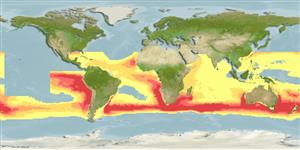Actinoptérygiens (poissons à nageoires rayonnées) >
Zeiformes (Dories) >
Oreosomatidae (Oreos) > Oreosomatinae
Etymology: Allocyttus: Greek, allos = other + Greek, kyttaros, kytos = a convex cavity.
Environnement / Climat / Gamme
Écologie
; marin bathypélagique; océanodrome (Ref. 51243); profondeur 0 - 1800 m (Ref. 50610), usually 800 - 1200 m (Ref. 6545). Deep-water, preferred ?; 28°N - 58°S
Eastern Atlantic: off Mauritania, Gulf of Guinea, Namibia and South Africa. Western Atlantic: off Suriname, southern Brazil and Uruguay. Western Indian Ocean: Mozambique Channel, Walters Bank. Eastern Indian Ocean: East Indian and West Australian Ridge, Australia. South Pacific: New Zealand and off Chile. Records from the North Pacific belong to Allocyttus folletti. Also Ref. 26139).
Length at first maturity / Taille / Poids / Âge
Maturity: Lm 28.0, range 23 - ? cm
Max length : 42.5 cm TL mâle / non sexé; (Ref. 27159); poids max. publié: 2.0 kg (Ref. 27124); âge max. reporté: 140 années (Ref. 39383)
Épines dorsales (Total): 5 - 8; Rayons mous dorsaux (Total): 28-33; Épines anales 2-3; Rayons mous anaux: 26 - 31. Adults blackish black in color; prejuveniles silvery, back greenish with large grey blotches that disappears at about 12 cm (Ref. 6548).
Occurs on the continental slope (Ref. 9563), forming large shoals over rough ground near pinnacles and canyons (Ref. 6390). Juveniles are pelagic and inhabit oceanic waters in depths of less than 1000 m (Ref. 27230). They tend to be dispersed over smooth grounds (Ref. 6390). Feeds on shrimps, cephalopods, and fishes (Ref. 6548). The eggs float near the sea surface and the larvae also inhabit surface waters (Ref. 6390). Trawl catch rates for warty oreos, and for oreos in general, show no evidence of vertical migration during day or night (Ref. 27150), even though many of the planktonic species consumed by this species undergo daily migrations within the water column (Ref. 6390).
Life cycle and mating behavior
Maturité | Reproduction | Frai | Œufs | Fécondité | Larves
Displays seasonally synchronised reproduction.
Karrer, C., 1990. Oreosomatidae. p. 637-640. In J.C. Quero, J.C. Hureau, C. Karrer, A. Post and L. Saldanha (eds.) Check-list of the fishes of the eastern tropical Atlantic (CLOFETA). JNICT, Lisbon; SEI, Paris; and UNESCO, Paris. Vol. 2. (Ref. 6545)
Statut dans la liste rouge de l'IUCN (Ref. 115185)
CITES (Ref. 94142)
Not Evaluated
Menace pour l'homme
Harmless
Utilisations par l'homme
Pêcheries: intérêt commercial mineur
Plus d'informations
RéférencesAquacultureProfil d'aquacultureSouchesGénétiqueFréquences alléliquesHéritabilitéPathologiesTraitementMass conversion
CollaborateursImagesStamps, CoinsSonsCiguateraVitesseType de nageSurface branchialeOtolithesCerveauxVision
Outils
Articles particuliers
Télécharger en XML
Sources Internet
Estimates of some properties based on models
Phylogenetic diversity index (Ref.
82805): PD
50 = 0.5635 [Uniqueness, from 0.5 = low to 2.0 = high].
Bayesian length-weight: a=0.01380 (0.00800 - 0.02383), b=3.06 (2.90 - 3.22), in cm Total Length, based on LWR estimates for this species & (Sub)family-body (Ref.
93245).
Niveau trophique (Ref.
69278): 4.2 ±0.73 se; Based on food items.
Résilience (Ref.
69278): Très faible, temps minimum de doublement de population supérieur à 14 ans (tmax=140).
Vulnérabilité (Ref.
59153): High to very high vulnerability (69 of 100) .
